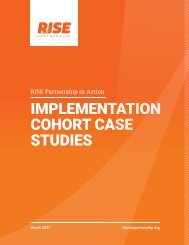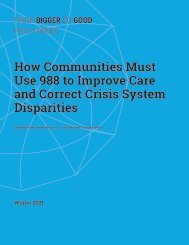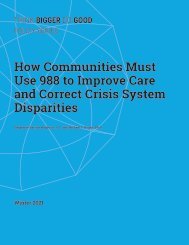Scattergood_IMD_Web
Create successful ePaper yourself
Turn your PDF publications into a flip-book with our unique Google optimized e-Paper software.
1 The <strong>IMD</strong> Rule Has<br />
Been an Important<br />
Driver of the Shift<br />
Toward Community<br />
Services<br />
The <strong>IMD</strong> exclusion rule, which has been in place since the beginning of the Medicaid<br />
program in 1965, bars the use of federal Medicaid funds to finance services for<br />
individuals ages 22 to 64 residing in “institutions for mental diseases” or <strong>IMD</strong>s—<br />
hospitals, nursing homes, or other institutions with more than 16 beds that are<br />
primarily engaged in providing diagnosis, treatment, or care of persons with “mental<br />
diseases” other than dementia or intellectual disabilities (1). Congress’s adoption<br />
of the rule reflected its view that serving individuals in mental institutions was<br />
a state responsibility. Lawmakers did not want federal payments to replace state<br />
financial commitments i .<br />
The rule’s enactment, coming two years after Congress passed the Community<br />
Mental Health Centers Act, also reflected congressional intent to promote a shift<br />
toward community-based services. In adopting the <strong>IMD</strong> rule, Congress explained<br />
that community mental health centers were “being particularly encouraged by<br />
Federal help under the Community Mental Health Centers Act of 1963,” that “often<br />
the care in [psychiatric hospitals] is purely custodial,” and that Medicaid would<br />
provide for “the development in the State of alternative methods of care and requires<br />
that the maximum use be made of the existing resources in the community which<br />
offer ways of caring for the mentally ill who are not in hospitals” (1).<br />
i. “The committee believes that responsibility for the treatment of persons in mental hospitals—whether or not they be assistance<br />
recipients—is that of the mental health agency of the State” (1). When Congress adopted the <strong>IMD</strong> rule, state psychiatric<br />
hospitals predominated and states generally did not pay for care in private psychiatric hospitals. Nevertheless, Congress<br />
also made the rule applicable to freestanding private psychiatric hospitals, likely reflecting the concerns about long-term<br />
institutional care described below and to encourage the use of community services and acute-care general hospitals instead.<br />
Medicaid’s Institutions for Mental Diseases (<strong>IMD</strong>) Exclusion Rule: A Policy Debate 10

















